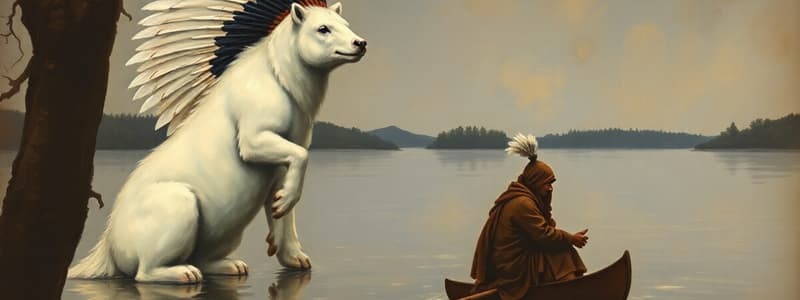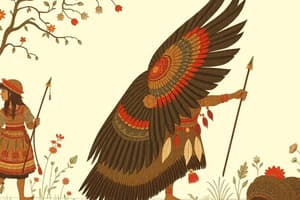Podcast
Questions and Answers
Match each Indigenous group with their typical summer housing:
Match each Indigenous group with their typical summer housing:
Haudenosaunee = Not mentioned for Summer (Longhouses year-round) Inuit = Animal skin tents Métis = Tents (nomadic lifestyle) Early Explorers = Not applicable
Match the following economic activities with the Indigenous group most associated with it:
Match the following economic activities with the Indigenous group most associated with it:
Haudenosaunee = Cultivating the 'three sisters' (corn, beans, and squash) Inuit = Ice Fishing Métis = Fur Trading European Settlers = Harvesting lumber
Match each group with their typical mode of transportation during the winter months:
Match each group with their typical mode of transportation during the winter months:
Haudenosaunee = Walking Inuit = Dog sleds Métis = Wagons and sleds pulled by dogs, horses, and oxen Early Explorers = Not applicable
Match the following features with the Indigenous group most closely associated:
Match the following features with the Indigenous group most closely associated:
Match the items with the Indigenous group that used it:
Match the items with the Indigenous group that used it:
Match the following locations with the Indigenous group most associated with it:
Match the following locations with the Indigenous group most associated with it:
Match the following challenges with its effect on Indigenous Populations:
Match the following challenges with its effect on Indigenous Populations:
Match the following descriptions with the Indigenous group that it best describes:
Match the following descriptions with the Indigenous group that it best describes:
Match the following spiritual beliefs with the Indigenous group most associated with it:
Match the following spiritual beliefs with the Indigenous group most associated with it:
Match the following types of food with the Indigenous group most associated with it:
Match the following types of food with the Indigenous group most associated with it:
Match the following tools with the Indigenous group most associated with it:
Match the following tools with the Indigenous group most associated with it:
Match the person to their description:
Match the person to their description:
Match the following seasonal adaptations with the Indigenous group most associated with it:
Match the following seasonal adaptations with the Indigenous group most associated with it:
Match the following economic impacts with the Indigenous group most associated with it:
Match the following economic impacts with the Indigenous group most associated with it:
Match the following statements with the most relevant group:
Match the following statements with the most relevant group:
Match the building with its purpose:
Match the building with its purpose:
Match the statement with the correct group:
Match the statement with the correct group:
Match the means of travel with the Indigenous groups that used it:
Match the means of travel with the Indigenous groups that used it:
Match the following impacts with the correct group:
Match the following impacts with the correct group:
Match each Indigenous group with how they were impacted when Europeans arrived:
Match each Indigenous group with how they were impacted when Europeans arrived:
Flashcards
Matrilineal Clan System
Matrilineal Clan System
A social structure where family lineage is traced through the mother's side.
Longhouses
Longhouses
Long dwellings made of wooden frames covered in bark, housing multiple families.
The Three Sisters
The Three Sisters
Corn, beans, and squash cultivated together by the Haudenosaunee.
Haudenosaunee Spiritual Beliefs
Haudenosaunee Spiritual Beliefs
Signup and view all the flashcards
The Inuit
The Inuit
Signup and view all the flashcards
Igloos
Igloos
Signup and view all the flashcards
Kayaks
Kayaks
Signup and view all the flashcards
Umiaks
Umiaks
Signup and view all the flashcards
Inuit Spiritual Beliefs
Inuit Spiritual Beliefs
Signup and view all the flashcards
Métis Nation
Métis Nation
Signup and view all the flashcards
Métis Cultural Blending
Métis Cultural Blending
Signup and view all the flashcards
Pemmican
Pemmican
Signup and view all the flashcards
Métis Spiritual Life
Métis Spiritual Life
Signup and view all the flashcards
Loss of Land
Loss of Land
Signup and view all the flashcards
European Diseases
European Diseases
Signup and view all the flashcards
Residential Schools
Residential Schools
Signup and view all the flashcards
Loss of Resources
Loss of Resources
Signup and view all the flashcards
Scurvy
Scurvy
Signup and view all the flashcards
Indigenous Healing Practices
Indigenous Healing Practices
Signup and view all the flashcards
Development of Hospitals
Development of Hospitals
Signup and view all the flashcards
Study Notes
The Haudenosaunee
- The Haudenosaunee had a matrilineal clan system.
- The Clan Mother headed the longhouse, inhabited by related females and their families.
- Men were responsible for hunting and building.
- Women were responsible for planting, harvesting, and meal preparation.
- They lived in longhouses constructed with wooden frames and bark coverings.
- Villages accommodated hundreds of residents and were fortified with protective walls.
- Relocation occurred when farmland lost its fertility.
- They cultivated corn, beans, and squash, known as the "three sisters".
- They gathered berries and nuts and hunted and fished.
- They believed in living in harmony with nature and in values and traditions gifted by the Creator.
- Their spiritual practices included ceremonies involving prayer, dance, stories, and songs, expressing gratitude to the Creator and the natural world.
The Inuit
- In summer, they lived in small family groups in animal skin tents.
- They hunted on land and water using kayaks during the summer.
- In winter, they formed larger settlements and lived in igloos or turf homes.
- They traveled by dog sleds and relied on ice fishing in winter.
- Snow igloos were used as temporary housing in winter.
- Animal skin tents were used as temporary housing in summer.
- Seasonal hunting patterns followed animal migrations.
- Summer hunting focused on caribou, seals, and walrus.
- Winter hunting focused on ice fishing and beaver.
- Specialized tools such as harpoons and kayaks were used.
- Family units consisted of 5-6 people.
- Resource sharing was community-based.
- Food was considered communal property.
- They had a collaborative work ethic.
- Dog sleds or foot travel were used in winter.
- Walking was used in summer.
- Kayaks were used for individual water travel in summer.
- Umiaks, large hide boats, were used for group water travel in the summer.
- They lived in the Northern Regions of Canada.
- Their homeland was called Inuit Nanangat, which included the land, water, and ice surrounding their territories.
- Economic activities were highly community-focused.
- Hunting and Fishing were primary economic activities.
- They traded with European explorers.
- They believed that all things (living and non-living) possess a spirit.
- Spirits existed in people, animals, inanimate objects, and natural forces.
- Afterlife was seen as a transition, not an end.
- Ceremonial practices included using a one-sided drum, singing, and storytelling through dance.
- Major festivals occurred during total darkness periods.
The Metis
- The Métis Nation are people of both First Nations and European heritage.
- This name was given to children born to European men (like explorers, fur traders, and settlers) and Indigenous women.
- Some lived in cabins and farmed.
- Others had a nomadic lifestyle, living in tents and following buffalo herds.
- They used dogs, horses, and oxen to pull carts, wagons, and sleds.
- They combined European and Indigenous customs.
- Their cooking and sewing skills ensured their survival in harsh winters.
- Métis communities were located along fur trading routes.
- These areas were in the Red River area (Manitoba), Saskatchewan and Alberta, around the Great Lakes (Ontario, Quebec), and near the Mackenzie River in British Columbia and the Northwest Territories.
- They played a significant role in fur trading, selling furs and getting European materials in return.
- They contributed to the North West Company and the Hudson’s Bay Company.
- They farmed and gathered food such as bannock, berries, and pemmican (a mix of buffalo meat, fat, and berries).
- They combined Christian beliefs (Protestant and Catholic) with traditional Indigenous spirituality.
- Fiddle music and intricate dancing were vital parts of their culture.
How Indigenous People Were Affected by European Settlers
- Europeans took land from Indigenous peoples for their own settlements.
- Taking land made it harder for them to hunt, fish, gather food, and maintain traditions.
- European settlers brought new diseases like smallpox and scurvy to which Indigenous peoples had no immunity.
- These diseases caused many deaths.
- Indigenous peoples' traditional ways of life were disrupted.
- They were forced to change their culture, language, and practices to survive.
- Indigenous children were forcibly taken from their families and sent to schools.
- In these schools, they were forced to abandon their languages and cultures, causing pain and trauma.
- Some children died, barely escaped, or were left with major injuries.
- Europeans took many resources from the Indigenous Peoples, such as furs and forests.
- Europeans taking resources affected Indigenous peoples' livelihoods and trade, as they depended on these resources for survival.
Medical Care in the 1700s
- Early explorers relied on First Nations knowledge for medical care.
- Indigenous medicine was passed down through generations.
- Settlers often suffered from Scurvy (a lack of Vitamin C).
- First Nations communities brewed tea from White Spruce twigs and bark to combat scurvy.
- Indigenous people created remedies using plants, making teas, poultices, and other drinks.
- Settlers adopted these practices to survive in North America.
- Hospitals emerged in cities like Quebec City, Montreal, and Toronto as populations grew.
- Many hospitals were established by Catholic missionaries and nuns.
- Poor individuals could visit hospitals for free care, while wealthier citizens opted for private doctors.
Studying That Suits You
Use AI to generate personalized quizzes and flashcards to suit your learning preferences.




